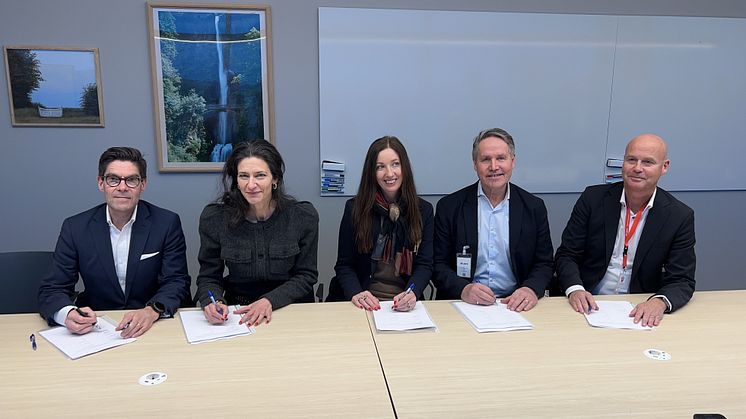
Press release -
New steps towards Malmö’s future carbon dioxide infrastructure
CMP, E.ON, Nordion Energi, Sysav and Uniper have signed a partnership agreement for the development of a CO2 hub in Malmö. The collaboration is part of the regional project Carbon Network South Sweden, CNetSS, and will carry out feasibility studies to investigate the conditions for an intermediate storage facility in Norra Hamnen.
CNetSS, a collaborative project between leading actors in energy and infrastructure, was launched in 2022 with the aim of collaborating on infrastructure solutions for transport and permanent storage of captured carbon dioxide.
During the first phases of the project, Malmö was identified as the most suitable location for interim storage of carbon dioxide. CMP, E.ON, Nordion Energi, Sysav and Uniper are now moving forward on local preparations in Malmö.
The parties have agreed to jointly further develop an infrastructure in Malmö for intermediate storage of carbon dioxide, as a stage before further transport to end users or permanent storage. The goal is also to promote Malmö and Skåne as an attractive region for industrial development, and to offer a cost-effective logistics solution for parties working on carbon capture.
“The port in Malmö plays a vital role in establishing the future carbon dioxide infrastructure. The framework of the partnership agreement, aimed at having an intermediate storage facility on site, creates new business opportunities for the port going forward. Now, with customers and partners, we are moving from words to action and taking concrete measures for a long-term contribution to the green shift,” says Barbara Scheel Agersnap, CEO, Copenhagen Malmö Port.
Large scale means lower costs
Together, the five actors will find economies of scale to reduce costs and realise the construction of the infrastructure. The partnership includes:
- Area and location for intermediate storage in Norra Hamnen
- Pipeline transport from production facilities
- Reception facilities for liquefied carbon dioxide by rail, truck or ship
- Liquefaction plant for carbon dioxide in gaseous form
- Loading for transport by ship to final disposal
- Business model for partners and additional customers
Further consultations with local stakeholders and interested parties will take place to ensure the comprehensive and sustainable development of the project. Intermediate storage is expected to be completed in 2028 and liquefaction in 2030.
The partnership agreement was signed on Monday afternoon at E.ON’s office by Malin Dahlroth, CEO, Sysav, Barbara Scheel Agersnap, CEO, Copenhagen Malmö Port AB, Johan Mörnstam, CEO, E.ON Energiinfrastruktur AB, Hans Kreisel, CEO, Nordion Energi AB and Johan Svenningsson, CEO, Uniper and Patrik Hermansson, Uniper.
The partnership is an important milestone for the companies involved and a sign of the region’s commitment to innovative solutions for carbon dioxide management and sustainable development.
Brief facts: CNetSS
CNetSS has the long-term goal of increasing the potential for emission reduction and negative emissions. Participants in phases 1 and 2 were Sysav, CMP Copenhagen Malmö Port), E.ON, Växjö Energi, Öresundskraft, Nordion Energi, Kraftringen, Höganäs, Kemira and Stora Enso. These phases resulted in the port in Malmö being identified as the most suitable location for an intermediate storage facility for carbon dioxide. The project has determined the amount and timetable of the quantities of carbon dioxide to be captured by the participants, the most appropriate transport methods to the intermediate storage facility, as well as the size of the storage facility and physical storage requirements. The project has been carried out with the support of Industriklivet.
The application for phase 3 has been initiated under the coordination of Nordion Energi. The goal is to concretise the business model, technology, costs and legal aspects prior to the procurement of a system solution.
Brief facts: CCUS – Carbon Capture, Utilisation and Storage
CCUS stands for Carbon Capture, Utilisation and Storage, a technology that captures carbon dioxide emissions from industrial sources and power plants. The aim is to prevent CO2 from being released into the atmosphere, which contributes to climate change. The process involves three main steps: capture, transportation and storage or use of the carbon dioxide. Carbon dioxide is captured either directly at the source of the emission or from the atmosphere. After capture, it is transported to a storage site, often an intermediate storage facility for further transport. The final destination for storage is usually underground geological formations, such as depleted oil or gas fields. Carbon dioxide can also be used as a raw material in fuels or new materials. CCUS is an important technology for achieving climate goals, especially in sectors where emission reduction is challenging.

